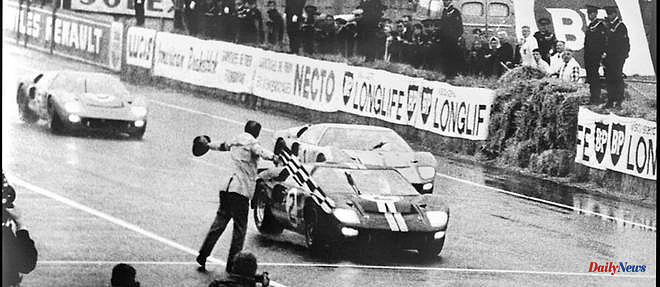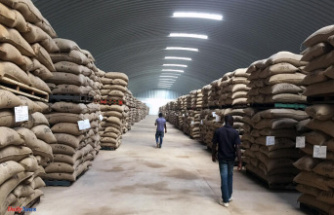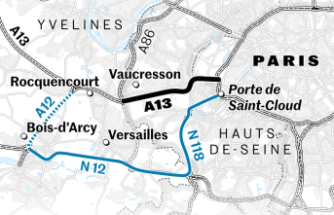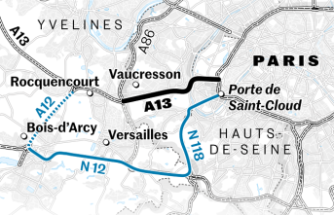Ford's entry into the 24 Hours of Le Mans in the early 1960s could have been just one marketing operation among many others, but it turned into a formidable human adventure due to the heightened rivalry between Henry Ford II and Enzo Ferrari, which was also the subject of the film Le Mans 66.
Envious of the sporting results of the brand with the prancing horse, the leaders of Ford first, in a pragmatic and very American way, purely and simply considered buying the small Italian manufacturer then still independent. Weary, jealous of his prerogatives as racing car team boss, Enzo Ferrari opposes them in unkind terms, which will have the gift of annoying Henry Ford II who then sets out to beat the Italian brand on home ground, that is, at the 24 Hours of Le Mans. The world famous French race was indeed then outrageously dominated by the Prancing Horse cars that won it in 1949, 1954, 1958, 1960, 1961, 1962, 1963, 1964 and 1965, sorry!
Completely lacking experience in the field of endurance events, Ford launched in 1963 the study of a specific racing car based on a Lola MK6. The GT40 was born. Powered by a 4.2-litre, ultra-low-slung Ford overhead V8 to reduce aerodynamic drag and increase top speed, it is named after its height measured in inches, 40 inches, or 1.02 meters. Engaged for the first time in the 24 Hours of Le Mans in 1964, it made an impression there from practice by exceeding 300 km/h on the Hunaudières straight, which was not however enough for it to claim pole position obtained by a Ferrari 330P driven by Englishman John Surtees.
However, it was a Ford GT40 which dominated the first hour of the race with the American Richie Ginther at the wheel before being overtaken by the Ferrari of Surtees. But reliability issues will quickly hit the official Ford team. Of the three GT40s entered, the first retired due to fire after 4 hours of racing, while the other two were delayed by technical problems affecting the gearbox in particular, leaving victory to Ferrari, which took the first three places. On the other hand, it is a Cobra Daytona driven by the Dan Gurney-Bob Bondurant pair that dominates the GT category ahead of the Ferrari GTOs. However, the Cobra Daytona is built and operated by a certain Carroll Shelby, a fine connoisseur of the 24 Hours of Le Mans for having been the first American driver to win in the Sarthe in 1959 at the wheel of an Aston Martin DBR1 which he shared with the English Roy Salvadori. The earthy Texan, already in partnership with Ford, which supplied him with the engines for his Cobras, was thus entrusted with the responsibility of running the GT40s from the end of 1964.
The results are not expected. The GT40, now MkII and now powered by a 7-liter V8 developing nearly 500 hp, won its first victory in early 1965 on the Daytona circuit. On the strength of this encouraging result, Ford landed in force in the Sarthe in 1965 with two 7-litre MkIIs and 4 GT40s (two 4.7-litres and two 5.3-litres). The MkII immediately made a strong impression on the 24 Hours of Le Mans circuit, where it took pole position in the 1965 edition in the hands of Phil Hill at an average of 227 km/h, relegating the first Ferrari to more than 5 seconds. driven by Surtees. The domination of the Ford MkIIs was confirmed at the start of the event, but transmission problems appeared after two hours of racing, which led to their retirement in the evening. The slaughter is total in the American clan, the four remaining GT40s having been decimated by an epidemic of ruptured cylinder head gaskets. The race was finally won for the ninth time by Ferrari with a 250 LM driven by Jochen Rindt and Masten Gregory. Height of humiliation for Ford, Ferrari also wins in GT with its new 275 GTB...
The Ford MkIIs logically took the lead at the start of the race, but the two Ferrari P3s of Rodriguez and Scarfiotti managed to get back in front thanks to their lower fuel consumption which allowed them to stop in the pits less often. Alas, Scarfiotti had to retire after colliding with another car, while Rodriguez was delayed by gearbox problems. Reliable in addition to being fast, three Ford MkIIs dominated the end of the race, to the point that the team asked them to regroup to cross the line in formation, thus illustrating the American triumph, which achieved a hat-trick ahead of four Porsche 906s, the first Ferrari being a GT, the 275 GTB/C driven by Piers Courage and Roy Pike which finished 8th.
While Ford announced that it would put its title back into play the following year, Ferrari was already preparing its weapons by developing the superb P4 which began the 1967 season with a bang by winning a hat-trick at Daytona on Ford land. A big alert for the American brand, whose 6 MkIIs entered for the occasion all gave up on mechanical failure while trying to keep up with the infernal pace imposed by the Italians.
Ford then reacted urgently by accelerating the development of its MkIV. Developed entirely in the United States, it features a new chassis, reinforced by an imposing roll cage after the accidental death of Ken Miles at the wheel of the first prototype, and an elongated body with reduced aerodynamic drag. Still powered by a powerful 7-litre V8, it proved to be very fast, exceeding 340 km/h on the Mulsanne Straight in the hands of Dan Gurney during the free practice session. But the MkIV is also much heavier (270 kg more) than the Ferrari P4, which puts its brakes to the test, so much so that the Gurney Foyt crew develops a piloting strategy consisting of taking the foot off the the accelerator well before the end of the straight to avoid overstressing the braking system when approaching the Mulsanne bend. This results in poor lap times that will mislead their competitors.
Thus, two hours after the start, it was the Ford of Gurney Foyt who was leading the race, the three other MkIVs launched in pursuit, competing for the best lap time at an average of more than 238 km/h. The three P4s entered by Ferrari only manage to limit the damage by refueling less often thanks to their lower fuel consumption. But the night brings bad luck to the Ford team with the brutal elimination of Mario Andretti's MkIV and the two MkIIs. B of Schlesser and McCluskey in the same pile-up, while Donohue McLaren's MkIV is delayed by clutch problems. The Ferrari P4s in ambush regain hope behind the Ford MkIV of Gurney-Foyt, but, against all odds, it continues to turn like clockwork and at a rate that the Italians will never be able to match. The Ford finally wins, but ahead of two Ferraris.
The 1968 edition is upset in more ways than one. The events of May which blocked France forced the organizers to postpone the race in September, a delay which was used to modify the circuit according to new regulations designed to improve safety. Finally, in order to reduce the performance of cars now deemed too fast, the International Sporting Commission imposes a cylinder capacity limit of 3 liters for prototypes, and 5 liters for sports cars whose production must exceed the minimum figure of 50 copies. Result, Ferrari withdraws, while the presence of Ford rests mainly on the engagement of GT40 modified by the team John Wyer and animated by V8 4.9 liters.
But the tests and the start of the race are dominated by the new Porsche 908 3 liters officially entered by the German mark. Willy Mairesse, 4th at the wheel of his Ford GT40 at the end of the start, leaves the track on the first lap due to a badly closed door; he was seriously injured when he had not fastened his harness to gain time during the "Le Mans" type start procedure. After 3 hours of racing, problems began for the Porsches, affecting the transmission for Siffert's 908, the clutch for that of Stommelen, the alternators for those of Mitter and Buzzetta. The GT40s retook the race lead in the evening, ahead of a Matra soon delayed by rain due to wiper failure, despite French driver Henri Pescarolo's heroic efforts to keep the car in the race, which eventually retired at the end of the morning due to a tire burst. In the lead, the Ford GT40 of Rodriguez and Bianchi won the race by 7 laps ahead of two Porsches.
In 1969, Porsche dominated the championship with its 908 8 cylinders and the German manufacturer intended to strike a blow with its new 917 12 cylinders. Opposite, the Ferrari 312P are not regular enough and the Ford GT40 are considered aging. But John Wyer's team nevertheless continued to develop the GT40 by equipping it with Gurney cylinder heads which increased the power of the 4.9-litre C8 to 420 hp. The surprise could also come from the young Matra team, which is entering four 3-litre prototypes.
The Porsches dominate the tests and it is the new 917 which takes the pole in the hands of Stommelen, the first Ferrari is at 13 seconds, the Ford GT40 of Ickx at almost 15 seconds. This did not prevent the young Belgian driver from winning the race after a thrilling final. This is the last absolute victory for Ford in the Sarthe. But the American giant will return there in 2016, 50 years after its treble of 1966, to win the GT category with the very spectacular and aptly named Ford GT...












